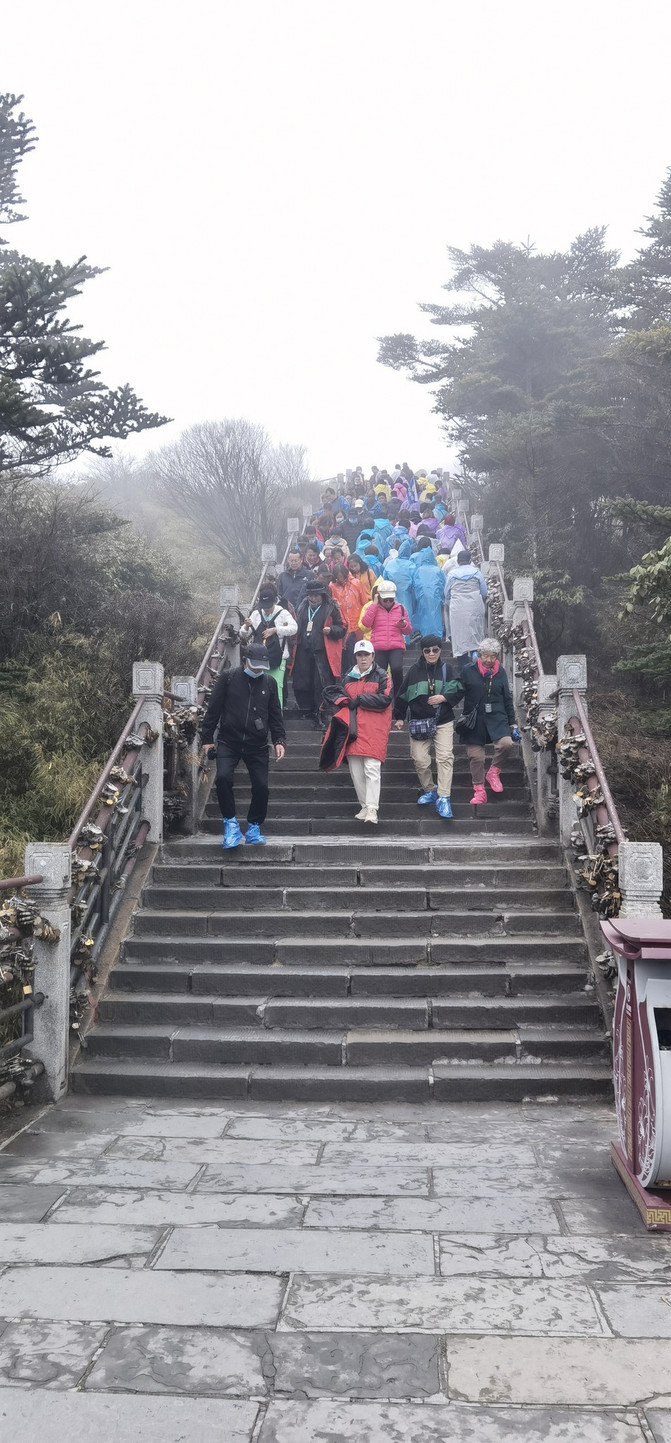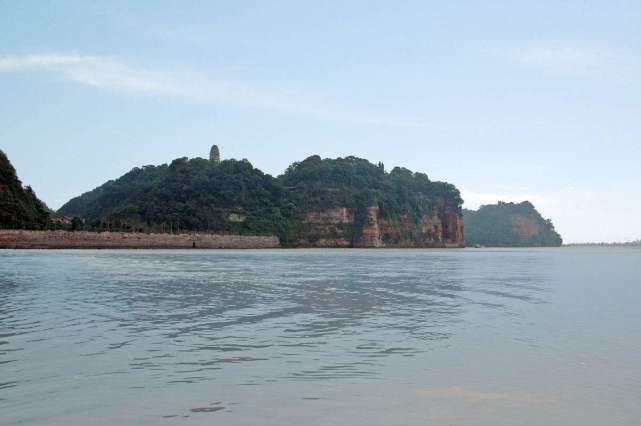land of abundance Happy Returning to Thinking of Shu (3)
Along the way, wild monkeys appeared, sometimes disturbing tourists, sometimes lively, naughty and cute.

visitors like weaving

Regis Rock
This stone is a stone from Mount Regis in Switzerland. In 2009, Mount Emei and Mount St. Regis in Switzerland agreed to make the two mountains sister mountains of friendship. At the same time, Mount Emei was placed on the top of the St. Regis in Switzerland, symbolizing China-Switzerland friendship.

The more you reach the summit, the heavier the fog. White elephants are decorated on both sides of the road. This is the mount of Samantabha Bodhisattva and the six-toothed white elephant.

Statues of Samantabhadra Bodhisattva on all sides and ten directions The copper-cast and gold-plated craft Buddha statue is 48 meters high and has a total weight of 660 tons. It consists of a pedestal and ten statues of Samannah on all sides. Among them, the pedestal is 6 meters high and 27 meters long and wide. It is engraved on all four sides with ten broad wishes of the Samanxian. The exterior is decorated with granite embossed. The statue of Samanxian is 42 meters high and weighs 350 tons. It originates from the "Forty-eight vows to save all sentient beings" in the Buddhist scriptures, which means Amitabha's forty-eight vows to save all sentient beings.

the body cliff, formerly known as Sacrifice Cliff.

huazang templewithinGolden Temple, made of pure copper.

After going down the mountain, we had a meal. After dinner, we went to the Xiangcheng Grand Theater to watch a theater called"Sacred Image Emei"performance.
"Holy Elephant Emei"It is a wonderful performance that demonstrates the beauty, majesty and cultural taste of Mount Emei. It has both technical performances with strong local characteristics and Sichuan's unique folk customs. The performance lasts for 90 minutes and consists of seven parts: "Fantasy, Elegance, Spirit, Shu, Gang, Dream and Zen". Among them, the fifth game,"Mount Emei Martial Arts Firm", is a display of Emei martial arts that combines strength and softness, cultivates both inside and outside, and has been ranked among the three major schools of Chinese martial arts along with Shaolin and Wudang since ancient times. It reflects the 2500-year cultural heritage of Mount Emei and is eye-opener.






Sculpture on Elephant City Square
Stay in the urban area of Emei Mountain.
D7
Leshan Giant Buddha, also known as the Lingyun Buddha, its real original name after verification isJiazhou Lingyun Temple Giant Stone Statue。It is located on the east bank of Nanmin River in Leshan City, Sichuan Province, beside Lingyun Temple. The Buddha is a sitting statue of Maitreya Buddha, 71 meters high. It is the largest cliff stone statue in China.
In ancient times, Leshan was located at the confluence of the three rivers. The Minjiang River, Qingyi River and Dadu River gathered at the foot of Lingyun Mountain. The water was quite fierce, and boats were often subverted here. Whenever there is a summer flood, the river hits the mountain walls, often causing the tragedy of shipwreck and death. Zen Master Haitong initiated the initiative in order to reduce the water flow and save all living beings. He recruited manpower and material resources to dig mountains to build Buddhas, and fill rivers with stones to slow down the water flow, benefiting both. Construction of the Buddha statue began in the early years of the Kaiyuan period of Emperor Xuanzong of the Tang Dynasty (713 AD). When the Buddha was built to its shoulders, Monk Haitong passed away. After Haitong's death, the project was temporarily interrupted. Many years later, Zhang Qiu Jianqiong, the governor of Jiannan Xichuan, donated his salary, and Haitong's apprentices led the craftsmen to continue building the Buddha. Due to the huge project, the court ordered a tax on hemp salt, which made the project progress rapidly. When the Leshan Giant Buddha was built to its knees, the successor Zhang Qiu Jianqiong moved his family to serve as a minister of the Ministry of Revenue, and the project was stopped again. Forty years later, Wei Gao, the governor of Jiannan Xichuan, donated his salary to continue building the Leshan Giant Buddha. Through the efforts of three generations of craftsmen, it took 90 years to complete the project until the 19th year of Zhenyuan of Tang Dezong (803 AD).

Su ShiTitle "Buddha"Words.

Rolling in front of you isdadu RiverandQingyi RiverParallel water, the turbulent water channel between the right and the building isminjiang RiverFrom the main road to the Buddha, three rivers flow in parallel.

After the three rivers flow in parallel, they flow along the Minjiang River.

The spiral passage on the right side of the Buddha Buddha was recently read on the news that the upward passage had been permanently closed in order to protect the stone wall, and a new road had been opened.

The well-known Leshan Giant Buddha at home and abroadThe mountain is a Buddha, the Buddha is a mountain。We went down from the left side of the Buddha to the foot of the Buddha, and then up from the right side. The difference is that the left channel is basically inside the mountain, while the right channel is outside the mountain (as shown in the picture above).

Some tourists boarded the boat and looked far away, while worshiping the Buddha on the boat was another scene. The sky is gloomy, and the water and sky are of the same color in the distance. The Buddha is guarding this place. Don't be afraid of demons invading the border!

The huge Buddha's feet are like ants under them.

It is said that the head of the Buddha was originally covered by a roof.

Lingyun temple Located on the top of Lingyun Mountain, it is also called the Great Buddha Temple because it is the location of the Buddha. It was built in the Tang Dynasty. Historical records show that Lingyun Temple existed before the excavation of the Buddha, more than 1,300 years ago. In the early years of Kaiyuan of the Tang Dynasty, the temple was expanded again when Buddha statues were dug. Later, it went through war and was destroyed many times. The existing Lingyun Temple was built during the Kangxi period of the Qing Dynasty.

I found the picture online to see a long-term perspective.

This is a complete picture of the reclining Buddha found on the Internet. It is said that it was discovered by a Cantonese. From a distance, the entire mountain looks like a reclining Buddha, and the Buddha is right at its heart. I wonder if it was a coincidence or a deliberate design by predecessors?
Return to Chengdu after the tour and continue visiting Chengdu's famouskuanzhai alley。
kuanzhai alley, is an antique courtyard house composed of wide alleys, narrow alleys, and well alleys arranged in parallel, all made of indigo bricks and tiles. It is an ancient Qing Dynasty street of a certain scale left over from Chengdu.Daci Temple, Wenshu TempleTogether, they are known as Chengdu's three major historical and cultural city protected districts.
In the fifty-seventh year of Kangxi (1718), after putting down the Jungar Rebellion, more than a thousand soldiers were selected to garrison Chengdu, and Mancheng was built on the basis of Shaocheng at that time. Only the Manchu Eight Banners lived in Mancheng. After the decline of Manchu Qing Dynasty, Mancheng was no longer a restricted area and people could enter and exit freely. Some foreign merchants took the opportunity to open pawn shops near Mancheng and purchase large quantities of the property of the flag bearers. A unique pattern has been formed in which descendants of flag men, dignitaries and nobles, and peddlers live all over the city.
In the early years of the Republic of China, the city managers at that time changed "hutong" to "alley". In the 37th year of the Republic of China (1948), during an urban survey, it was said that after measuring, the staff at that time would randomly mark the wider alley as "wide alley", the narrower one was the "narrow alley", and the one with a well was the "well alley".
Today, the overall spatial style of the renovated wide and narrow alleys is relatively complete, continuing the style of western Sichuan folk houses in the Qing Dynasty. The street belongs to the northern hutong streets and alleys: the "fish spine"-shaped road pattern, and the buildings are integrated by barracks dormitories and western Sichuan folk houses. The spatial scale of the street is defined by the buildings and courtyard walls on both sides. The wide alley is about 7 meters and the narrow alley is about 5 meters. The buildings along the street are one to two floors and the height is also 5 to 8 meters.
This is the second time I have come here.

Kuan Alley: A nostalgic area with an old face, its name was Xingren Hutong during the Xuantong period of the Qing Dynasty. Most of them are buildings dating from the late Qing Dynasty and the early Republic of China, as well as some Western-style buildings left behind by the church.





Kuan Alley is a "leisure life" area and a reproduction of life in old Chengdu. There is the Old Chengdu Life Experience Hall on the wide alley, where both the customs and old Chengdu folk customs are here.


Narrow alleys used to be calledTaiping Hutong.


Narrow Alley: An extension line of the favorite atmosphere of petty bourgeoisie. This is the "slow life" area, showing the courtyard culture of old Chengdu. Most of these courtyards are occupied by stylish bars and restaurants. They are an exquisite lifestyle area with the theme of Western catering, light catering, coffee, art and leisure, healthy living halls, and characteristic cultural theme shops.



Jingzi Lane: A scene in old Chengdu, named Ruyi Hutong, or Mingde Hutong in the Qing Dynasty. After the Revolution of 1911, it was renamed "Jingxiang". On the remaining half of the street, a 500-meter-long brick culture wall and a 500-meter-long folk photo wall have been built on the other side of the street.

After browsing, we found an online celebrity shop-Mom's Hoof Flowers, and ate it and feast on it.
Previous Article:Meidu takes you to experience the charm that Chengdu cannot replicate
Next Article:October 2021-Self-driving tour around Chengdu
